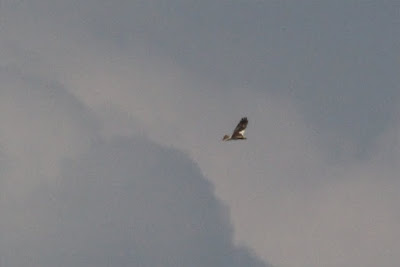 |
| Little Woolden Moss |
After a rather indolent few days I thought I'd best get some exercise with a walk across the mosses from Irlam.
July is generally a quiet and difficult month for seeing and hearing small birds but the blackbirds, goldfinches and greenfinches in the hedges along Astley Road were having none of that and made themselves noisily conspicuous. The whitethroats and blackcaps were quieter than usual, having hungry mouths to feed is a full-time job. The adult robins tended to skulk while the young robins fed out in the open. There are more young robins in production given the beakfuls of insects the adults were carting about.
 |
| Irlam Moss |
A buzzard flew over towards New Moss Wood. A male kestrel flew into the trees by the first field of turf. I looked around for the usual female and instead found two youngsters — a male and a female judging by their size — sitting with the woodpigeons on the phone lines over the other end of the field. (I bumped into the female a little further on at Annabel's Farm).
There wasn't much on the turf fields besides a couple of magpies on one of the field margins. Turf fields can seem a bit like a green desert landscape but they must have something happening in them otherwise there wouldn't be flocks of swallows hawking over them at knee height.
It wasn't until I saw the first one at Hephzibah Farm that I realised I hadn't been seeing any carrion crows. It turned out they were attending turf lifting operations on the other side of the motorway. (No sign of the Jack Russell that makes sure you're passing by and not stopping, either. I hope he's OK.) On the other hand there were quite a few yellowhammers, including three or four males singing from the foliage at the tops of the trees by the road.
The hedgerows were mostly quieter the other side of the motorway, at least up to the stables near Four Lanes End where a couple of chiffchaffs and a family of moorhens added themselves to the day's tick list. Flocks of crows, black-headed gulls and lesser black-backs busied themselves around the turf-lifting operations.
I'd seen a report of a wood sandpiper in a field a couple of hundred yards further up Astley Road this lunchtime so instead of turning go to Little Woolden Moss I carried on down the road. I spent a while looking in that field and a couple of damp fields across the road from it but all I managed to achieve was to unsettle the lapwings and draw the attention of horseflies. Still, well worth a go and nothing lost in the process.
 |
| Cotton grass, Little Woolden Moss |
Little Woolden Moss was surprisingly quiet, and quietly surprising. It was a warm afternoon so I wasn't expecting a frenzy of bird activity on the pools but a complete absence of gulls or waders was a surprise. A family of pied wagtails skittered around the bunds, barging into a couple of yellow wagtails as they bounced about. All the willow warblers had too much in their beaks for singing. The meadow pipits seem to have had a good year judging by the numbers shuffling between the pools and the potato field on the other side of the reserve.
 |
| Mosslands Farm |
I joined the path to Glazebury in the company of a family of reed buntings and some more meadow pipits. There'd been reports of a singing quail in the usual place yesterday so I spent a lot of time stopping and listening hopefully. No luck, just yet more meadow pipits with their parachute song and a couple of skylarks. I walked down between the field of ripe barley and the potato field, both of which were full of even more meadow pipits. A male emperor dragonfly patrolled the tops of the barley, the bright green and blue of its body dazzling against the old golds of the barley.
 |
| Male marsh harrier, Mosslands Farm |
I was so intent on watching the harrier floating off towards the horizon that I didn't notice that the bush I was standing by had the Channel wagtail in it until the bird broke my concentration by calling loudly and flying across my eyeline before darting off towards the polytunnels. I didn't catch sight of it again, nor of any other yellow wagtails though I could hear a couple calling from the potato field with the meadow pipits.
Odd bird noises caught my ear as I walked down the path towards the farm buildings. I couldn't place them, though I found where the kestrel had retreated to after it was buzzed by the hobby. The mystery was solved when I turned the corner and found an odd assortment of chickens fussing about under a tractor. A rooster, a cheerful looking ginger hen and a young cock that looked more like a wild red jungle fowl than a farmyard bird. They had five chicks with them: one buttercup yellow, one black, one creamy yellow, one dark brown and one nearer white than beige. A very odd assortment.
 |
| Along Moss Lane |
Walking down Moss Lane there were more pied wagtails and whitethroats amongst the spadgers and goldfinches. The swallows on the fields were joined by sand martins as I approached the Glaze Brook. The water was high on the brook and there were a couple of family parties of well-grown mallard ducklings dabbling by the banks.
I'd just missed the bus to Leigh from Glazebury. No matter, I could wait ten minutes for the bus to Warrington and get the train home. Fifty minutes later I got the next bus after the one that didn't turn up. No matter, it had been a good outing.

No comments:
Post a Comment